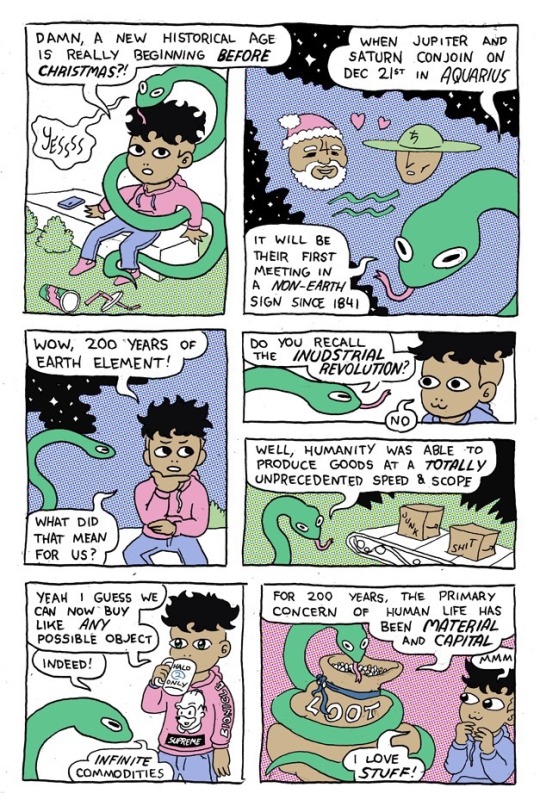#industrial age
The most pertinent astrological event of our time is the once-every-two-centuries procession of the elements in the Jupiter-Saturn synodic cycle. In December 2020, we are moving from an earth age to an air age. I will be cataloguing reflections and predictions, as well as amplifications of the elements and their zodiacal signs.

Food is the Reward
We say that Venus, ruler of taurus and libra, governs ethics and aesthetics. Ethics is the more immaterial, and best represented by libra, the air sign. Aesthetics is concrete, and best represented by taurus, the earth sign. Taurus is the sign of food, values, and art. We talk about tasting food and having taste in art. Taste in art is essentially a measure of appropriateness, and so are our values. “[Something], in what measure?” A tone of voice, a texture, a shape or color. Recall, taurus also rules money. Wealth in what measure? What results in pleasure.
What is this association between the material and value? Why does something hold more value if it is objective and physical?
Tina Fey once said something very wise: that the only real reward is food. When you are celebrating a success, the feeling is cemented by food. Regardless of scale. Finished fixing a pipe at home? Have a nice lunch. Successfully stage the opening night of your epic opera? Go out to dinner. The act of consumption is tied to the success of the deed, this is especially obvious on the occasion of a toast. Not only does the food tether the success around it, but it binds together the people who are sharing in it. We see that food is not only a consolidated symbol of value, but that it also concentrates the group into a set of values. Thus food is a bedrock of tribal life and tribalism. How offended is the tribe when you refuse to eat with them, or in their manner?
The word “binding” means three things: attaching, reinforcing and restricting. Tribal life is restricted by convention, but the affixing of concrete images and values to the symbolic order of the tribe fortifies its strength by providing it new organs, new capacities. In alchemical psychology, the stage of “coagulation” is all about the affixing of images, and closely relates to the process of personification. When a psychological complex is given an image—or better yet, personified—it is far easier to deal with. But the carrying around of an image that has been outgrown is, of course, restrictive. So images must not be permanent. Our bodies too are images, and they are beautiful and valuable because they die.
The attachment to our bodies is very important for life. If we did not care about our bodies and find them beautiful we would die much faster. “Let your wicked desires keep you pinned to this earth so your work could go on,” wrote Jung to his suicidal friend. Desire keeps us in life, and the desire of all the beings within us keep the body together. The countless microorganisms within do not have minds, but they have wants.
Dissolution Under Analysis
Supposing that there is a mesh of matter underlying the various objects of the world. After all, bodies die and buildings fall to rubble and then to dust. So if we think about matter as a whole, without its temporary approximate forms, it certainly is a diffuse mesh, a matrix. Then the cohering of that mesh into one of these forms is a desire.
Consider also the process of logic, which must operate upon abstractions that have been crystallized into units. Set theory, for instance, deals with the abstraction of set, drawn into coherence by its categorization as a set. Each member of a set is also itself a set. It is sets all the way up and down. So it is the bundling of axioms, the coagulation of the set, that makes it all operable.
An Amp for Christ
When Christ came to earth, he vitiated the magical projections of animism. The spirits of nature withdrew from the rocks and trees. This is the root of the opposition between Christianity and paganism. The keynote here is that Christ did this by taking these projections upon himself—he sheathed himself in the symbols of the world. This was an axial moment in the development of consciousness, where people realized they could find all the spirits of the world inside themselves. Here psyche could make an integral step in its pivot to self-reflection. We don’t know what the world appeared like preceding or directly after this event, but we might imagine that the world of matter suddenly appeared much more real and substantial.
And he said something about how he was the living bread, and from then on people have been eating his body in the form of the Eucharist. Is this part of his great deed, to make explicit the bundling of values that goes into a physical object? And that the consumption of the physical object brings with it an isomorphic psychological change?

We Want Stuff
The Industrial Age, the age of earth, came after the Enlightenment, the age of fire. And it is clear how science and reason set the stage for all the marvelous technology of industry. The achievements of the Enlightenment were very exciting, but somewhat abstract, and so did not look like much. It is the movement from age to age, from principle to machine, that gave us something to look at.
Then with this new industrial speed, we had so much to look at. We have now a lot of stuff. Without effort, I can get a mug with anything I want on it and in it. So many, many objects.
As stated, matter is energy drawn into form by desire and objects are therefore crystalizations of desire. So we desire objects. And we want them because they radiate their energy, their love upon us. A statue painstakingly carved from marble can sit in one’s home for a very long time and continue to radiate, to unfold new dimensions. It took a lot of desire for it to get here. A mass-produced object, not so much.
Lacan’sobjet petit a is the object of desire that is never attained, because once it is attained, the desire fades. But the more something is wanted, the longer it can radiate its magic upon us once we have it. Things that take longer or are harder to find are obviously going to stoke more desire, and radiate for longer once they are in our apartments.
Because goods are produced so fast, we have to compensate for this through artificial anticipation: a culture of drops. The new sneaker is about to come out, better cop at launch. A Funko Pop based on a guy I like will be released shortly—I had better be the first to click. The Funkos are terrific examples because of their monstrously dead eyes and immobile bodies, and their interchangeability implying disposability, though the character they represent is always predicated on some attachment. We loved him, once, didn’t we? When we saw him in the show, and he surprised and delighted us? If only I could have a reminder of that in my home. Yet once the package arrives we just set him onto the shelf and expect him to do all the work. We do not vivify these collectibles; the sneakers are too nice to wear out, so we put them on display. The Funkos often do not even escape their sad little boxes.
When a child plays with toys, they nurture the object so it can continue radiating itself upon them. The beloved toy is another being, an animate partner, and they continue to want it even though they have it, because the breath of life comes into it, and it continually creates new experiences. It is born anew through play. This resembles certain rituals of old, where the cosmic origin is recreated, and the human participants are born anew with the world. The creation of the world is constant, it is only whether we care to be involved again. Spirit is breathing its love into matter always, always.

We have less than 2 weeks before the new astrological epoch! “The air age.” I would like to use this time to celebrate this historical transition. Here’s a comic for starters
